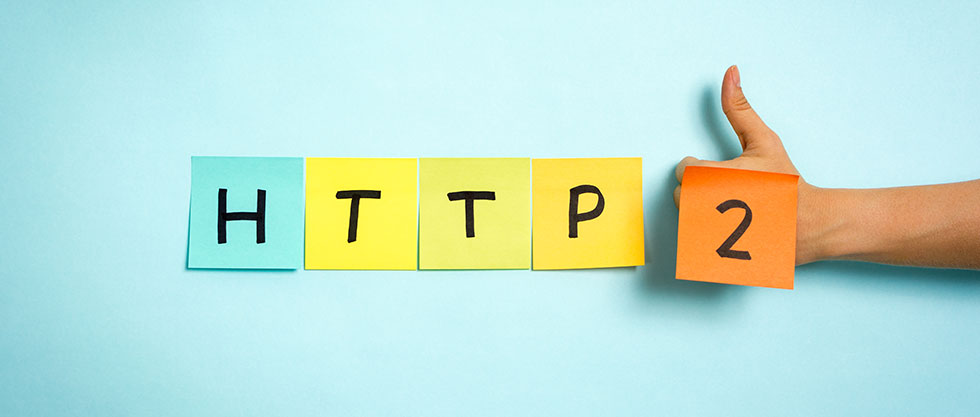The web has just got faster, thanks to the latest version of HTTP
HTTP/2 is the biggest upgrade since 1999 to the protocol that supports the World Wide Web (www) as we know it today.
Hypertext Transfer Protocol (HTTP) is known to most as the https:// at the beginning of a web address. In tech. terms, it regulates links between a web browser and the server hosting a website and it’s a core component of the internet, invented by Sir Tim Berners-Lee (the father of the world-wide web).
What does this mean for me & my business?
HTTP/2 means speed, speed, and more speed, creating a better user experience for your customers.
The main goal of HTTP/2 is to produce a lightweight and prompt delivery of http requests and responses, which is a bottle-neck of many modern-day websites still being served via an older version of HTTP.
So, what benefits will my business website see from changing over to HTTP/2?
- Faster load times/ less waiting for impatient customers
- More data security – everyone loves that
- Mobile friendly optimisation due to streamlined loading
- Less dependency on ‘web-hacks’
- If all else fails and a user is still using an old browser, HTTP/2 is backward compatible!
Here’s some nerdy details
HTTP/2 is actually based on Google’s SPDY (pronounced ‘Speedy’) concept, which was designed to speed up the loading of web pages and enhance users’ browsing experience. It’s a new standard and will take over from the current protocol HTTP1.1 used by most web sites/ servers on the internet today. With HTTP/2, your website can actively prioritise content that it expects will be requested by a user. It can anticipate data that a browser will request and deliver the response before an actual request is made.., cool huh?
The result of this is a vastly sped-up page load by eliminating back-and-forth latency. Servers can also prioritise content helping browsers decline to load content they don’t need.
HTTP/2 is supported by recent versions of Chrome, Opera, Firefox, Internet Explorer 11, Safari, Amazon Silk, and Edge browsers.
The web has noticeably evolved over the last couple of decades, but HTTP – the workhorse of the web – has not. Web developers are working around HTTP’s restrictions but:
- Operation still falls short of full bandwidth utilization
- Web design and maintenance are more complicated
- Resource consumption increases for client and server
- Cache capacity of resources suffers
The release of HTTP/2 is an attempt to address the different shortcomings and inflexibilities of HTTP/1.1.
How has Page Speed Improved with HTTP/2?
- Multiplexing and concurrency – A number of requests can be sent in quick succession on the same TCP connection. And replies can be received out of order – eliminating the need for multiple connections between the client and the server.
- Stream dependencies – The client can indicate to the server which resources are more important.
- Header compression – The HTTP header size is reduced significantly.
- Server push – The server is able to send resources the client is yet to request.
With the release of HTTP/2, you will not have to change your websites or applications to make sure they continue to work properly. Your application code and HTTP APIs continue to work uninterruptedly, your application is likely to perform better and consume fewer resources both from client and server side.
Is it Necessary to Change Our Websites?
HTTP/2 is backwards-compatible with HTTP/1.1; so, it is possible to ignore it completely and everything will still continue to work as before. The protocol change is totally transparent to users.
If you have a Gmail account and also use Chrome to access it, you must have been using SPDY and then HTTP/2 without knowing anything about it.
However, many things that you consider as best practice can be damaging to the performance under HTTP/2. Over time, as more servers are updated to use HTTP/2 and more people have browsers that support HTTP/2, your website may not be well optimized according to the best practices and will start to seem slower than websites optimized for the new protocol.
Do we need to make changes to our website or web servers to embrace HTTP/2?
In a nutshell, most likely! To move to HTTP/2, your server software may have to be restructured to support the protocol – which may be simple or almost impossible depending on how your websites are being hosted.
Before restructuring your website, particularly for HTTP/2, you will also need to consider whether your visitors tend to have a browser that is compatible. Websites with a lot of traffic that are being run on up-to-date browsers will be able to make that switch sooner than websites that show a majority of users on older browsers.
Are we ready to change to HTTP/2?
It’s worthwhile investigating this and working out if it can be done and at what cost. Our technicians can analyse your website and server technologies to see if your compatible, and if not we can assist to make the necessary changes to take advantage of HTTP/2.

